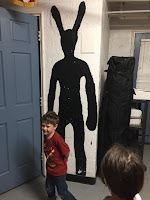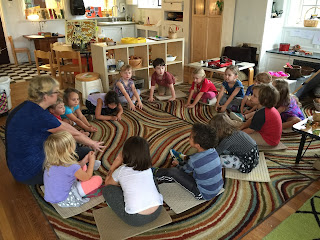Is place a language? Do children use the affordances of particular spaces to express their deep thinking? To connect to others?
I'm not sure about "place" being a language- for me the jury is still out. The environment is considered the third teacher in our approach to teaching, so inherently place provides the foundation for individuals to express their thinking...
 |
The dark cedar closet
in the attic- was the attraction
to this space the darkness?
|
 |
One of the favorite spots when
visiting the attic was the dark
cedar closet- or the "attic's attic" as
it was phrased by our students.
|
As the children safely confront the fear of the dark at the top of the stairs, and the mystery of unknown worlds, story-telling becomes a satisfying way to explore these experiences and to share it with others. Tales from the attic has become a multiple chapter story, written by several Rainbow Room students, that the authors want to make into a movie. Whimsy and magic thread these stories, connecting the real world attic to an imaginary fairy world. Interestingly, the Rainbow Room is the ultimate destination in each story; the protagonists consistently return to their classroom to share their adventures. Is this one way that place is a language for our students?
  |
After exploring the attic over many trips, a group composed, then performed Tales from the Attic for the rest of the class, then took feedback from their peers.
|
The consideration of place, too, challenges the schema that young children have about time. An abstract concept, preschool children are beginning to understand the relativity of time, including past and future, and our "place" is certainly full of history and apparent change. Recently, a group undertook an inquiry into: where did the Meadow Room go? One student's older brother attended the Meadow Room only a few years ago, and now that space is our movement studio. A small group of children surmise that it must have moved somewhere. The tricky part seems to be the identity- the location is still in existence, but the identity has changed. Can a known identity just disappear? Even though the students clearly understand that there's no more "Meadow Room", the pursuit of its location continues (it must be behind the little door in the attic!)
To further explore the mansion and its affordances, small groups started to visit the basement. For those children new to Sabot, a visit to the basement can feel daunting with its dark, wet spaces, the noisy furnace (a behemoth!), the echo-filled light studio, and the mysterious and possibly sinister black bunny wall painting. For the seasoned visitor, the basement inspires its own form of magical whimsy- shadow play, echo exploration, and black bunny narratives.
   |
| The anthropomorphic black bunny; shadows in the light studio in the basement; more dark spaces to explore |
The forest next to our campus is another provocative space, with its unpredictable wildness and otherworldly peacefulness when one steps into its midst. We've observed children using this space to challenge themselves, both physically and socially, through "safe" risk-taking of terrain exploration and relationship-building. Do the mysteries of the remote forest create more uncertainties, taking us out of our comfort zones?
We find unexplored terrain in the forest (where does the tunnel go?); challenge our bodies and minds; and rely on each other for reaching our goals.
The classroom itself was a novel space at the beginning of the school year, with some new routines,
new relationship opportunities, new materials. A certain reservation to this new place is expected, but we have lately noticed an emerging mastery of the classroom's use. To this end, the Rainbow Room students have undertaken the manipulation of our large classroom environment. The desire to create a
 |
Even the bathroom is a space for learning-
here children draw a toilet for their house
|
 |
Our morning meeting was an experience new to many of
our students. We collaborated on a social story to describe
the expectations of this gathering.
|
 |
Presenting their observations about water color and light, the catalyst discovery
that prompted the creation of our dark classroom
|
  |
More opportunity for shadow exploration in our dark classroom; the well-lit classroom was not ideal for exploring the
relationship between light and water color as seen here.
|
 |
| Darkness is necessary to observe the affordances of light, water color, and glass |
 |
| The dark space sets the stage for light exploration, including the intensity, color, and ephemeral-quality of light |








